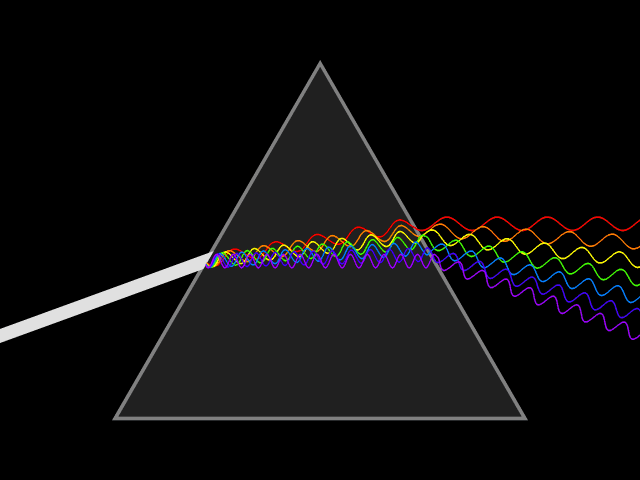File:Light dispersion conceptual waves.gif
Light_dispersion_conceptual_waves.gif (640 × 480 pixels, file size: 1.14 MB, MIME type: image/gif, looped, 90 frames, 4.5 s)
File history
Click on a date/time to view the file as it appeared at that time.
| Date/Time | Thumbnail | Dimensions | User | Comment | |
|---|---|---|---|---|---|
| current | 17:09, 6 April 2010 |  | 640 × 480 (1.14 MB) | Kalki | Reverted to version as of 04:14, 27 February 2008 |
| 17:07, 6 April 2010 |  | 640 × 480 (1.17 MB) | Kalki | Reverted to version as of 03:31, 27 February 2008 | |
| 04:14, 27 February 2008 |  | 640 × 480 (1.14 MB) | LucasVB | ||
| 03:31, 27 February 2008 |  | 640 × 480 (1.17 MB) | LucasVB | {{Information |Description=Copnceptual animation of dispersion of light in a prism. Using waves. |Source=self-made |Date=2008-02-27 |Author= Lucas V. Barbosa (aka Kieff) |Permission=Public domain |other_versions=Light_dispersion_conceptual. | |
| 04:10, 24 December 2007 |  | 640 × 480 (348 KB) | LucasVB | {{Information |Description=Dispersion of light inside a prism. Now with waves. |Source=Self |Date=2007-12-24 |Author=Lucas V. Barbosa |Permission=Public Domain |other_versions=Image:Light_dispersion_conceptual.gif }} |
File usage
The following 56 pages use this file:
- Dispersion (optics)
- Dispersive prism
- Dyakonov–Voigt wave
- Optics
- Wave
- Wavelength
- Talk:Dispersion (optics)
- Talk:Optics/Archive 2
- Talk:Prism (optics)
- User:Amarprabhu
- User:Backvoods
- User:Btweenthepipes97
- User:Cboi Sandlin
- User:Chrose
- User:Clarince63
- User:Code16
- User:Code16/Userboxes/Inventing Science FTW~!
- User:Dioluisf
- User:Editor510/ListeningPinkFloyd
- User:Egregiouslizard
- User:Enkyo2/Sandbox-Q
- User:Faskunji
- User:Fordescortracer
- User:InverseHypercube/Userboxes
- User:Israbelle
- User:Kjetil82
- User:Kygopy
- User:LucasVB/Gallery
- User:MaxEspinho
- User:NythilN1k0
- User:OliverEastwood
- User:PFC12
- User:Redwoodking
- User:VGrigas (WMF)/Quality Media
- User:Velociraptor888
- User:Vizmap
- User:Willrocks10/Userboxes
- User:XXEmoPunk911Xx
- User:XXalyXx
- User:Yoire
- User talk:LucasVB
- User talk:Moheen
- User talk:Moheen/Header
- User talk:Moonreach
- Wikipedia:Featured picture candidates/Animated light dispersion
- Wikipedia:Featured picture candidates/Composite light wave dispersion
- Wikipedia:Featured picture candidates/November-2010
- Wikipedia:Featured picture candidates/October-2024
- Wikipedia:Featured pictures
- Wikipedia:Featured pictures/Sciences/Others
- Wikipedia:Featured pictures thumbs/81
- Wikipedia:Picture peer review/Archives/Oct-Dec 2008
- Wikipedia:Picture peer review/Light Dispersion
- Wikipedia:Userboxes/Music/Bands/04
- Wikipedia talk:Userboxes/Archive 13
- Portal:Science
Global file usage
The following other wikis use this file:
- Usage on af.wikipedia.org
- Usage on am.wikipedia.org
- Usage on ar.wikipedia.org
- Usage on ary.wikipedia.org
- Usage on ast.wikipedia.org
- Usage on as.wikipedia.org
- Usage on azb.wikipedia.org
- Usage on az.wikipedia.org
- Usage on ba.wikipedia.org
- Usage on bcl.wikipedia.org
- Usage on bg.wikipedia.org
- Usage on bn.wikipedia.org
- Usage on bn.wikiquote.org
- Usage on bs.wikipedia.org
- Usage on ca.wikipedia.org
- Usage on ceb.wikipedia.org
- Usage on cs.wikipedia.org
- Usage on cy.wikipedia.org
- Usage on da.wikipedia.org
- Usage on el.wikipedia.org
- Usage on en.wikibooks.org
- Chemical Sciences: A Manual for CSIR-UGC National Eligibility Test for Lectureship and JRF/Electromagnetic radiation
- Physics Course/Types of Waves/Light Waves
- Climatology/Insolation
- Planet Earth/2c. Electromagnetic Radiation and Black Body Radiators
- Planet Earth/print version
- Climatology/Printable version
- Usage on en.wikiquote.org
View more global usage of this file.


